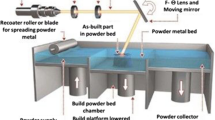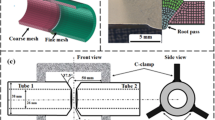Abstract
The residual stress distribution in the surface layer of bearing ring raceway has a significant impact on the fatigue life of rolling bearings. Grinding is the critical manufacturing process for bearing rings, and directly determines the residual stress distribution. However, the residual stress distribution is generally not detected in the manufacturing procedure of rolling bearings, and there are no corresponding control standards or measures. This research intensively investigated the grinding mechanism of bearing ring raceway, and performed an integrated modeling to achieve controlled stress grinding. The integrated modeling starts from the grain/workpiece interaction, through modeling of the distributions of interaction stresses and heat flux, and ends up with the numerical model for coupled thermal-mechanical residual stress analysis. The integrated modeling was validated experimentally through the comparisons between the measured and simulated temperatures and residual stresses. With the integrated model, the generating mechanism of the residual stress distribution was revealed, the influences of grinding parameters and cooling conditions were investigated, and the control strategy was finally put forward. The investigations show that grinding can produce compressive residual stresses in the surface layer of bearing ring raceway. Heat flux is still detrimental to the formation of compressive residual stresses, although thermally induced tensile residual stresses are prevented. To produce compressive residual stresses in the surface layer of bearing ring raceway, the rotational speed of bearing ring should be increased, the rotational speed of grinding wheel and the transverse feed speed should be reduced, and increasing convective heat transfer coefficient is more effective than reducing the initial temperature of grinding fluid.
Similar content being viewed by others
References
Schwach DW, Guo YB (2006) A fundamental study on the impact of surface integrity by hard turning on rolling contact fatigue. Int J Fatigue 28(12):1838–1844
Davim JP (2008) Machining: fundamentals and recent advances. Springer, London
Choi Y, Liu CR (2006) Rolling contact fatigue life of finish hard machined surfaces: part 1. model development. Wear 261(5):485–491
Choi Y (2009) A study on the effects of machining-induced residual stress on rolling contact fatigue. Int J Fatigue 31(10):1517–1523
Guo YB, Warren AW, Hashimoto F (2010) The basic relationships between residual stress, white layer, and fatigue life of hard turned and ground surfaces in rolling contact. CIRP J Manuf Sci Technol 2(2):129–134
Matsumoto Y, Hashimoto F, Lahoti G (1999) Surface integrity generated by precision hard turning. CIRP Ann Manuf Technol 48(1):59–62
Kishi K, Eda H (1972) Analysis of the structure and thermal residual stress in the machined surface layer by grinding. Trans Jpn Inst Metals 13(6):412–418
Mishra A, Prasad T (1985) Residual stresses due to a moving heat source. Int J Mech Sci 27(9):571–581
Vansevenant E, Peters J (1987) An improved mathematical model to predict residual stresses in surface plunge grinding. CIRP Ann Manuf Technol 36(1):413–416
Kovach JA, Malkin S (1988) Thermally induced grinding damage in superalloy materials. CIRP Ann Manuf Technol 37(1):309–313
Li YY, Chen Y (1989) Simulation of surface grinding. J Eng Mater 111(1):46–53
Mahdi M, Zhang L (1997) Applied mechanics in grinding - V. thermal residual stresses. Int J Mach Tool Manu 37(5):619–633
Gupta R, Sekhon GS, Shishodia KS (1997) Stress due to a moving band source of heat and mechanical load on the work surface during grinding. J Mater Process Technol 70(1):274–278
Mahdi M, Zhang L (1998) Applied mechanics in grinding - VI. Residual stresses and surface hardening by coupled thermo-plasticity and phase transformation. Int J Mach Tool Manu 38(10):1289–1304
Mahdi M, Zhang LC (1999) Residual stresses in ground components caused by coupled thermal and mechanical plastic deformation. J Mater Process Technol 95(1):238–245
Yu XX, Lau WS (1999) A finite-element analysis of residual stress in stretch grinding. J Mater Process Technol 94(1):13–22
Mahdi M, Zhang L (1999) Applied mechanics in grinding. Part 7: residual stresses induced by the full coupling of mechanical deformation, thermal deformation and phase transformation. Int J Mach Tool Manuf 39(8):1285–1298
Moulik PN, Yang HTY, Chandrasekar S (2001) Simulation of thermal stresses due to grinding. Int J Mech Sci 43(3):831–851
Hamdi H, Zahouani H, Bergheau JM (2004) Residual stresses computation in a grinding process. J Mater Process Technol 147(3):277–285
Shah SMA (2011) Prediction of residual stresses due to grinding with phase transformation. Ph.D. thesis. Institut National des Sciences Appliquees De Lyon, France no. D’ordred: 2011ISAL0048
Shao Y, Fergani O, Li B, Liang SY (2016) Residual stress modeling in minimum quantity lubrication grinding. Int J Adv Manuf Technol 83(5–8):743–751
El-Helieby SOA, Rowe GW (1980) A quantitative comparison between residual stresses and fatigue properties of surface-ground bearing steel (En 31). Wear 58(1):155–172
Dölle H, Cohen JB (1980) Residual stresses in ground steels. Metall Mater Trans A 11(1):159–164
Torbaty S, Moisan A, Lebrun JL, Maeder G (1982) Evolution of residual stress during turning and cylindrical grinding of a carbon steel. CIRP Ann Manuf Technol 31(1):441–445
Mittal RN, Rowe GW (1982) Residual stresses and their removal from ground En31 steel components. Metals Technol 9(1):191–197
Vansevanant E (1987) A subsurface integrity model in grinding. Ph.D. Thesis. Katholieke Universteit te Leuven, Belgien
Matsuo T, Shibahara H, Ohbuchi Y (1987) Curvature in surface grinding of thin workpieces with superabrasive wheels. CIRP Ann Manuf Technol 36(1):231–234
Lau WS, Wang M, Lee WB (1991) A simple method of eliminating residual tensile stresses in the grinding of low carbon steels. Int J Mach Tool Manu 31(3):425–434
Tönshoff HK, Wobker HG, Brunner G (1995) CBN grinding with small wheels. CIRP Ann Manuf Technol 44(1):311–316
Österle W, Li PX, Nolze G (1999) Influence of surface finishing on residual stress depth profiles of a coarse-grained nickel-base superalloy. Mat Sci Eng A 262(1):308–311
Kato T, Fujii H (2000) Temperature measurement of workpieces in conventional surface grinding. J Manuf Sci Eng 122(2):297–303
Grum J (2001) A review of the influence of grinding conditions on resulting residual stresses after induction surface hardening and grinding. J Mater Process Technol 114(3):212–226
Kompella S, Farris TN, Chandrasekar S (2001) Techniques for rapid characterization of grinding wheel-workpiece combinations. Proc Inst Mech Eng B J Eng 215(10):1385–1395
Capello E, Semeraro Q (2002) Process parameters and residual stresses in cylindrical grinding. J Manuf Sci Eng 124(3):615–623
Balart MJ, Bouzina A, Edwards L, Fitzpatrick ME (2004) The onset of tensile residual stresses in grinding of hardened steels. Mat Sci Eng A 367(1):132–142
Chen X, Rowe WB, McCormack DF (2000) Analysis of the transitional temperature for tensile residual stress in grinding. J Mater Process Technol 107(1):216–221
Xiao G, Stevenson R, Hanna IM, Hucker SA (2002) Modeling of residual stress in grinding of nodular cast iron. J Manuf Sci Eng 124(4):833–839
Walsh DG, Torrance AA, Tiberg J (2006) Analytical evaluation of thermally induced residual stresses in ground components. Proc Inst Mech Eng C J Mech Eng Sci 217(5):471–482
Malkin S, Guo C (2008) Grinding technology-theory and applications of machining with abrasives. Industrial Press, New York
Jiang J, Ge P, Sun S, Wang D (2017) The theoretical and experimental research on the bearing inner ring raceway grinding process aiming to improve surface quality and process efficiency based on the integrated grinding process model. Int J Adv Manuf Technol 93(1–4):747–765
Wang D, Ge P, Bi W, Jiang J (2014) Grain trajectory and grain workpiece contact analyses for modeling of grinding force and energy partition. Int J Adv Manuf Technol 70(9–12):2111–2123
Yan L (2010) Research on grinding mechanism of hardened cold-work die steel based on single grain cutting. Ph.D. Thesis. Hunan University, Changsha
Merchant ME (1945) Mechanics of the metal cutting process. I. Orthogonal cutting and a type 2 chip. J Appl Phys 16(5):267–275
Marinescu ID, Rowe WB, Dimitrov B, Inasaki I (2004) Tribology of abrasive machining processes. William Andrew Publishing, New York
Hadad M, Sadeghi B (2012) Thermal analysis of minimum quantity lubrication-MQL grinding process. Int J Mach Tool Manu 63:1–15
Rowe WB (2001) Thermal analysis of high efficiency deep grinding. Int J Mach Tool Manu 41(1):1–19
Guo YB, Liu CR (2002) Mechanical properties of hardened AISI 52100 steel in hard machining processes. J Manuf Sci E T ASME 124(1):1–9
Acknowledgements
The work was supported by the National Natural Science Foundation of China (Grant No.51705272), the Taishan Scholar Project of Shandong Province (Grant No. ts201511038), the National Natural Science Foundation of China (Grant No. 51775289), and Key Laboratory of High-efficiency and Clean Mechanical Manufacture at Shandong University, Ministry of Education.
Author information
Authors and Affiliations
Corresponding author
Rights and permissions
About this article
Cite this article
Wang, D., Sun, S., Jiang, J. et al. From the grain/workpiece interaction to the coupled thermal-mechanical residual stresses: an integrated modeling for controlled stress grinding of bearing ring raceway. Int J Adv Manuf Technol 101, 475–499 (2019). https://doi.org/10.1007/s00170-018-2916-7
Received:
Accepted:
Published:
Issue Date:
DOI: https://doi.org/10.1007/s00170-018-2916-7




